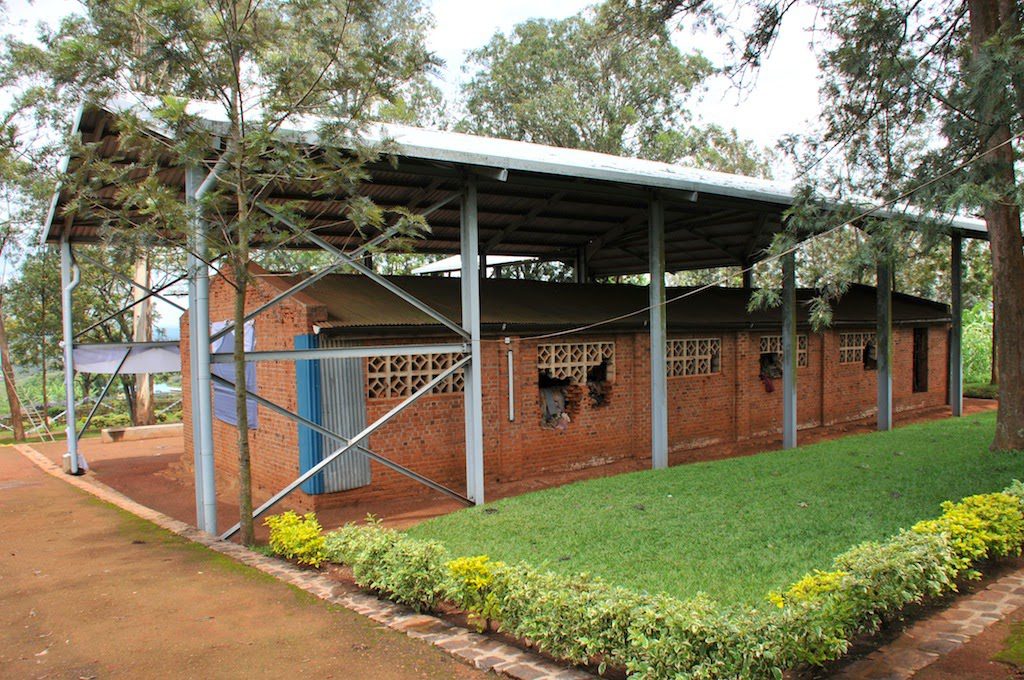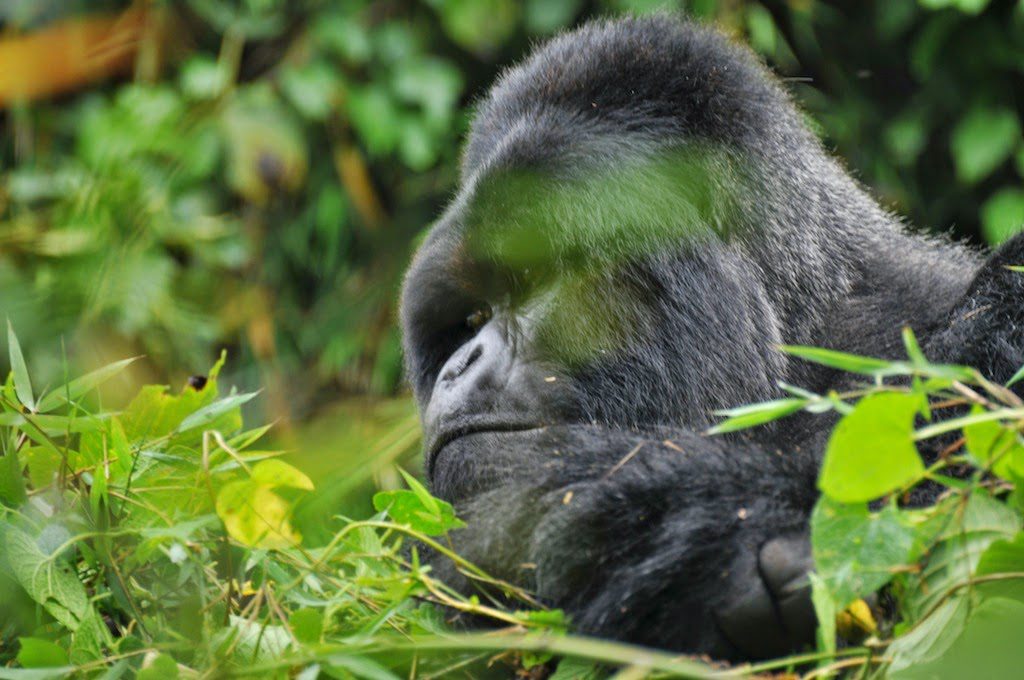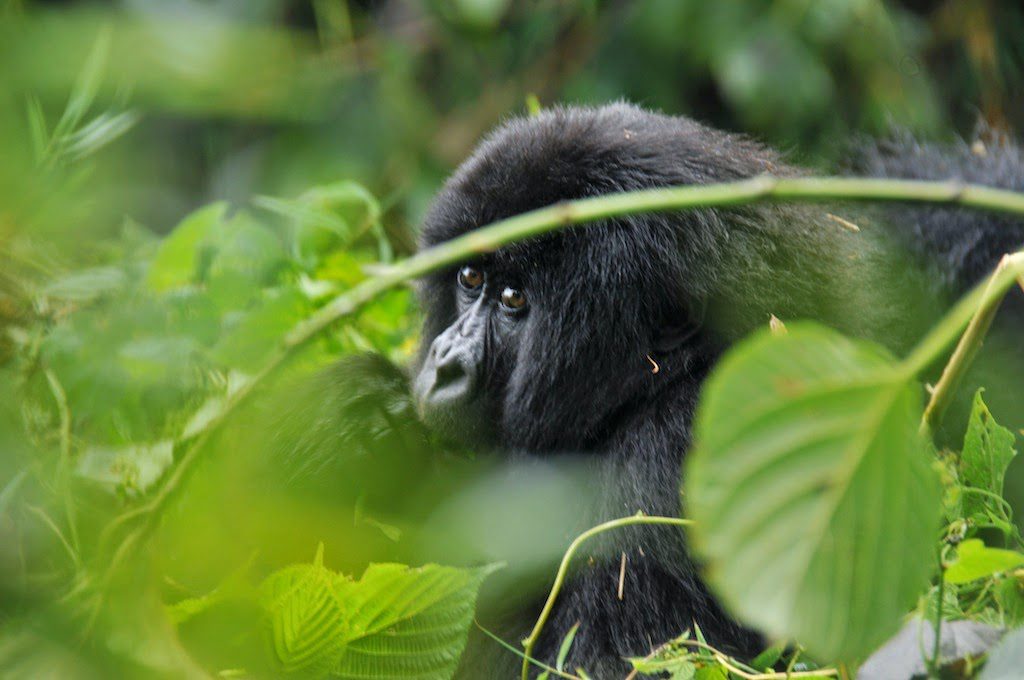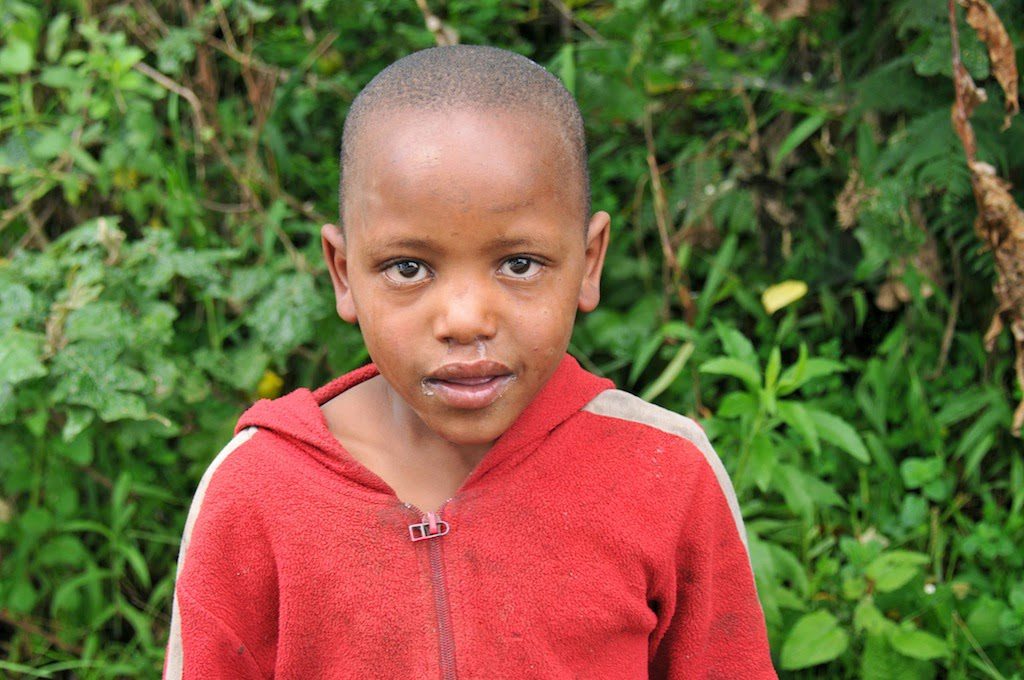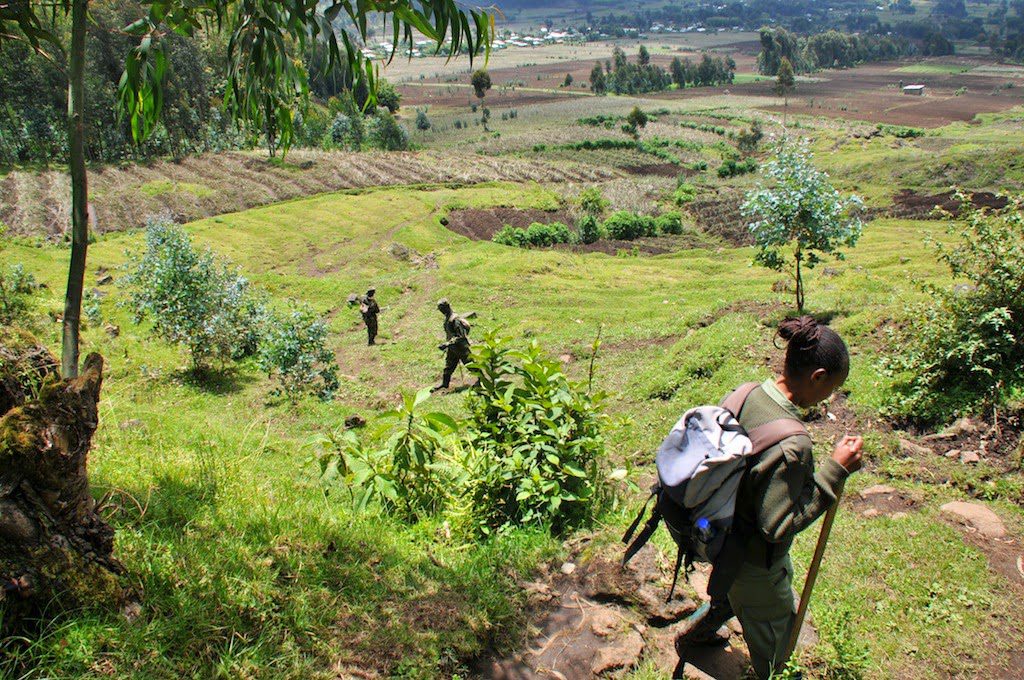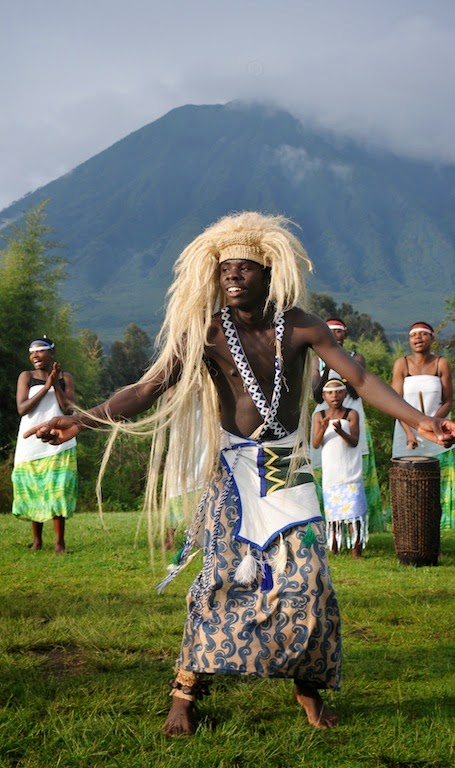Gorillas in the Mist… and Mud (Rwanda Part 2)
Rwanda in Kigali: scrambled eggs, fresh pineapple, Africa tea (with freshly
ground ginger which gives it a kick). Lucian, our driver, arrived and whisked
us away to see the two famous memorial churches, where thousands were massacred
in the genocide. The Genocide happened 20 years ago, from April 6 through July.
Over 800,000 died in three months, in the most brutal ways possible, Hutu vs.
Tutsi, with the Hutu extremists trying to exterminate the Tutsis, which they
called inyenzi—“cockroaches.”
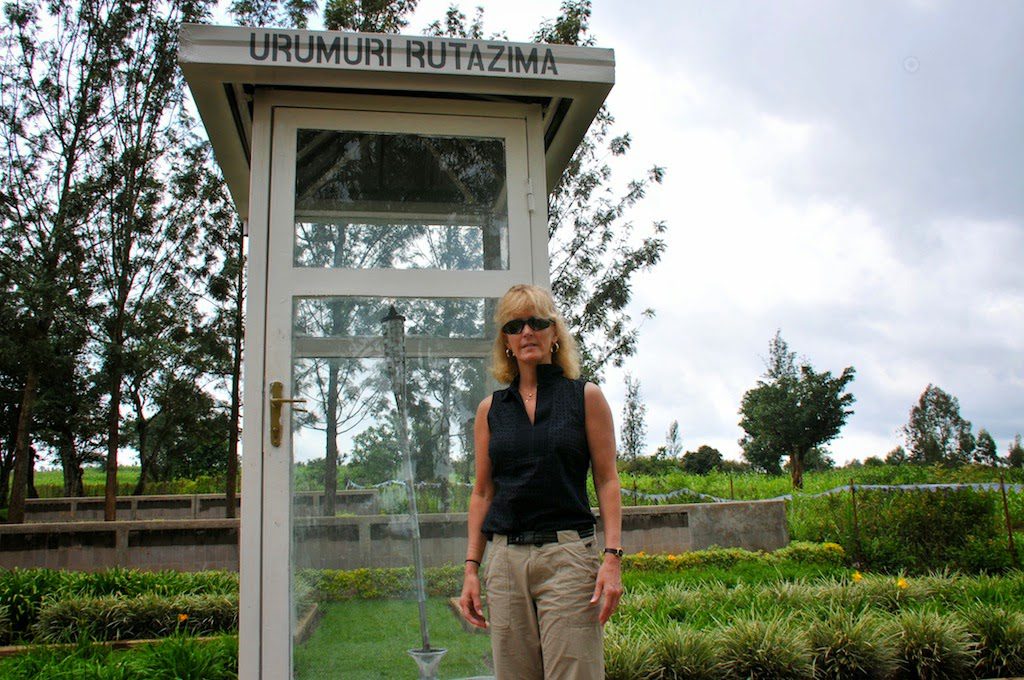 |
| Laurie Kelley at the Eternal Flame |
deep red, color of the earth of Rwanda. How can so small a building hold the
sadness of the eternity?
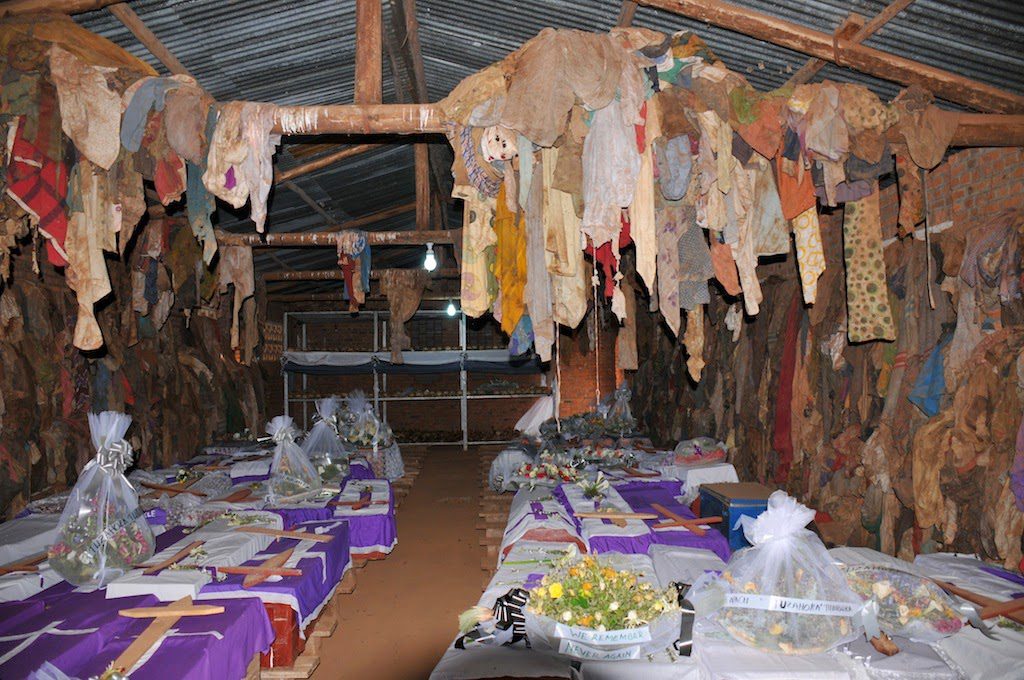
was 36 but looked much younger; she was 16 when the genocide took place. We were told not to take photos, but she relented and I tipped her well. The Eternal Flame was slightly pitiful; just a tiki torch that someone fills now and then
with oil. Inside the church it was breathtakingly horrid. The first sense is how small and dark the church is; then the smothering feeling as you see skulls and femurs and pelvises to your right neatly stacked on shelves as you enter, and then the actual clothing of the victims, dried and stiff with their 20-year-old
blood, piled on the rafters, hanging over your head. It feels suffocating.
belongings, including one identification document stating that the victim was
Hutu.
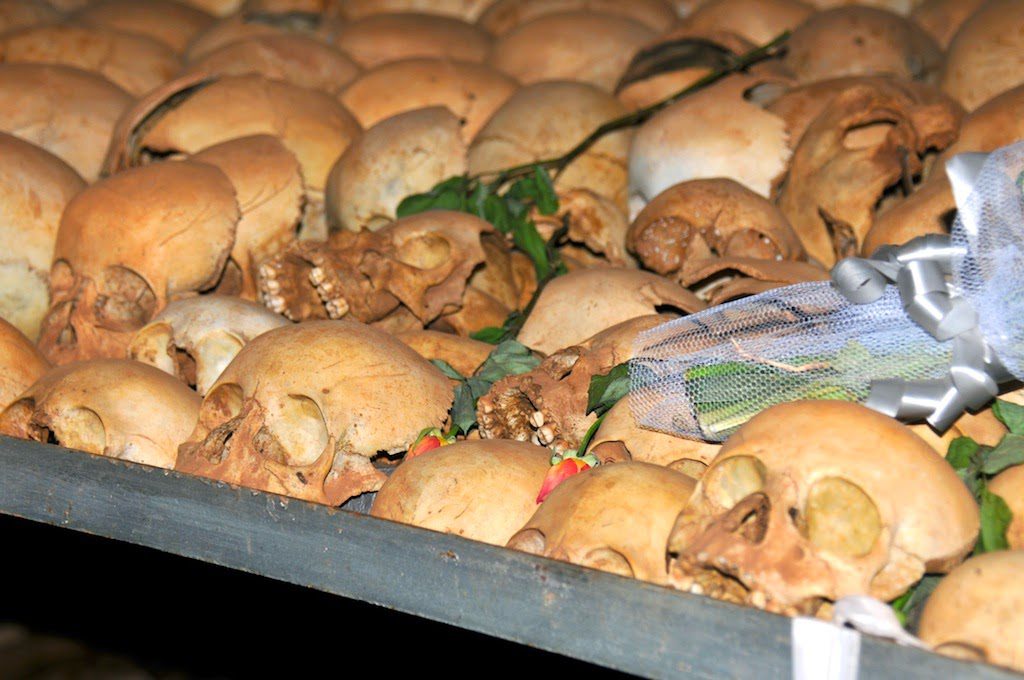
you have a family? Such horrors. Whole families were removed from the face of
the earth and for all time. No one will ever recall them, show videos or photos
of them or build a memorial or scholarship in their name. It’s as though they
never existed.

Grenades blew holes in the wall into which more grenades were thrown. Machetes hacked to death the innocents. In an adjoining building, the children’s Bible study room, a large red stain on the wall was a ghastly memorial to where children were bashed against the brick and left to die. The kitchen was the most terrible as it looked exactly as it had that day when fire decimated it. Everything in it was broken, and covered with the fine red dust of Rwanda. No one disturbed it. People were slaughtered here.
of the victims: a watch, a wallet, a comb. The alter cloth was stained red with blood, and left
untouched for 20 years. Downstairs, a glass enclosed display of skulls, with a
glass floor, through which we could see straight through to the cellar. Under
display was a coffin. In the coffin, unseen now, but originally displaying the
body as it was found, a woman with a baby on her back, who had been gang raped, then had a spear shoved through her up towards her neck, and then was stabbed through the heart, which went through the baby. She was
displayed like that, spear and all, for years until finally she was interred.
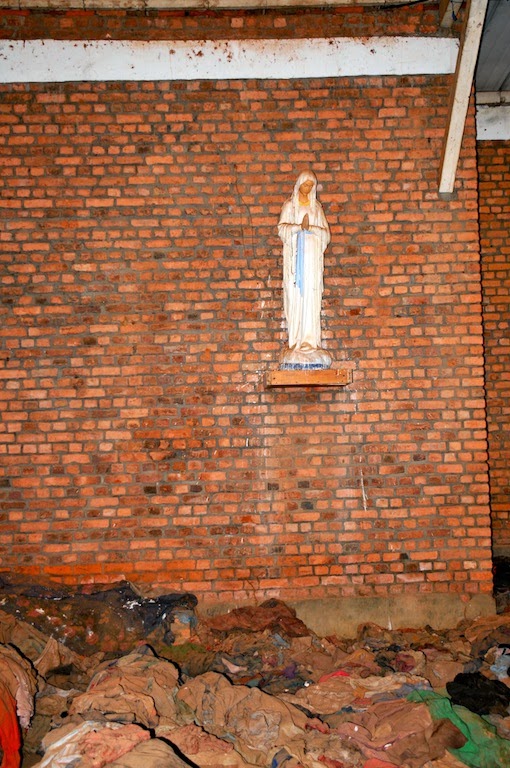
As
we exited in shocked silence, a brightly dressed older woman, with strong
features and a scowl, waited outside for us. The sister of the interred woman. Why
was she suddenly here? Maybe because it was Easter, maybe because it was the 20th
anniversary, but something in me somehow said she is here to try to earn a
little cash from sympathetic Americans. We put some Rwandan dollars in the donation box.
offered to take us to the presidential palace, Habyarimana’s palace. Habyarimana’s death in 1994 sparked the genocide. This was a
boring tour, mostly because we couldn’t understand the guide well. The palace
was not in great shape. There were photos on display from the genocide, which tore at my heart, especially the children with their hollow stares. The most
interesting part was peering out the yard and seeing the actual wreckage of the
plane crash which killed him. On April 6, 1994, someone (to this day no one
claims responsibility) shot Habyarimana down (and the president of Burundi) as
he flew back from attending the Arusha peace accords. His plane landed right in
his own backyard, where his wife could see it. The wreckage is amazing.
 This morning I awoke at 5:30 am, and hastily dressed in the chilly air to
This morning I awoke at 5:30 am, and hastily dressed in the chilly air toprepare for the gorilla trek. I loved putting on my trekking clothes and gear,
and it made me so content and happy inside to know I could go out exploring. The
road to the gorilla sanctuary on the volcano was brutally ragged, all pitted
magma rocks, mud and stones. A few precarious and narrow wood slat bridges. Out
of the simple homes along the route poured out children, most in dirty clothes,
they themselves dirty wearing a hodgepodge of clothes. All smiling and waving
to us, “Allo!” they cheered!
upended in clumps in the carefully groomed fields, green trees stretching up
toward a dominating volcano in the background. The Land Rovers pitched back and
forth over the rough terrain. Finally we reached the spot and disembarked. We
hiked about 30 minutes only, through the ploughed fields, through thick bamboo
forests where one guide had to machete his way in, up mud hills, and over
little streams. We met up with our trackers, who had found the “Hirwa” family,
consisting of a nine gorillas: a silverback (“Lucky,” so-called as he gets all
the females), three adult females, two sub-adult females (not able to mate
yet), one one-month old, and three year old twins.
so like us. When our guide, Patrick, was telling us about the male gorilla’s
habits— he gets drunk on one of the plants, fights with the other young males
and then cheats with the females— I asked, “We are talking about gorillas, right?”
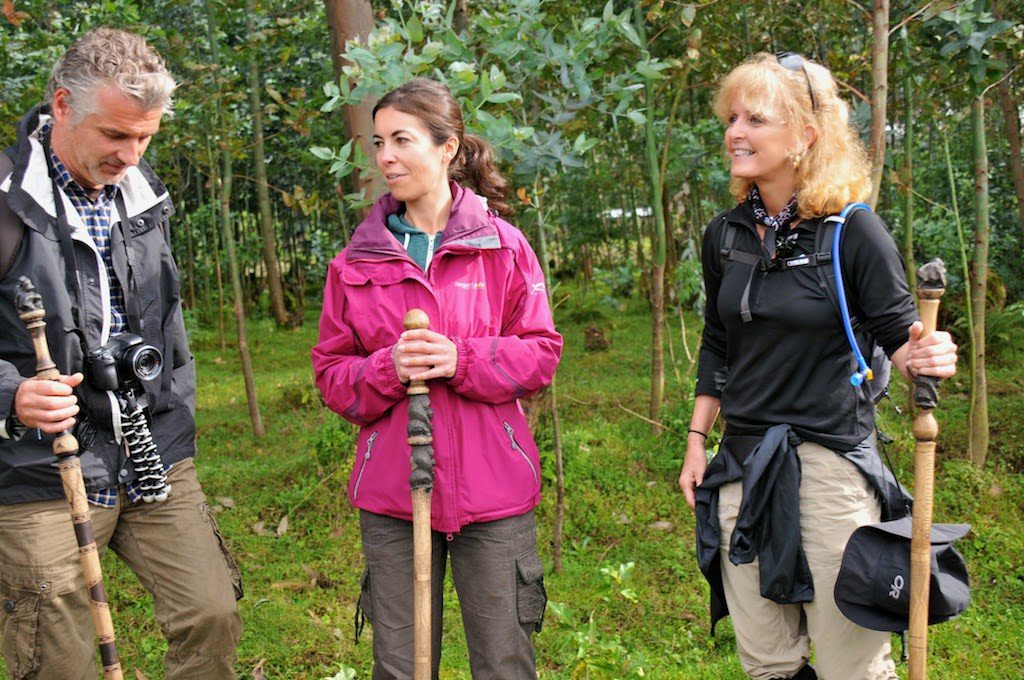
We first spied the mother with the one-month-old, just above our heads on a soft mound of earth. All around us is forest, or perhaps jungle? Thick, green, perfect cover for these gentle giants. We could get in close, and snapped many photos. No flash is allowed as this reminds the gorillas of lightning, of which they are afraid. Then another gorilla appeared, and another.
mountain gorilla. He issued deep, guttural grunts, and our guides responded. We snapped and videotaped for 15-20 minutes when suddenly Munyinya jumped down, and somehow commanded the entire troop to come to him. Each members obeyed and
lowered themselves to stand next to him. He was only a few feet away from members of our group!
 After one hour we had to leave. The gorillas only tolerate visitors so long. A happy walk back with lots of excitement at having seen these beautiful, intelligent, endangered
After one hour we had to leave. The gorillas only tolerate visitors so long. A happy walk back with lots of excitement at having seen these beautiful, intelligent, endangeredanimals.
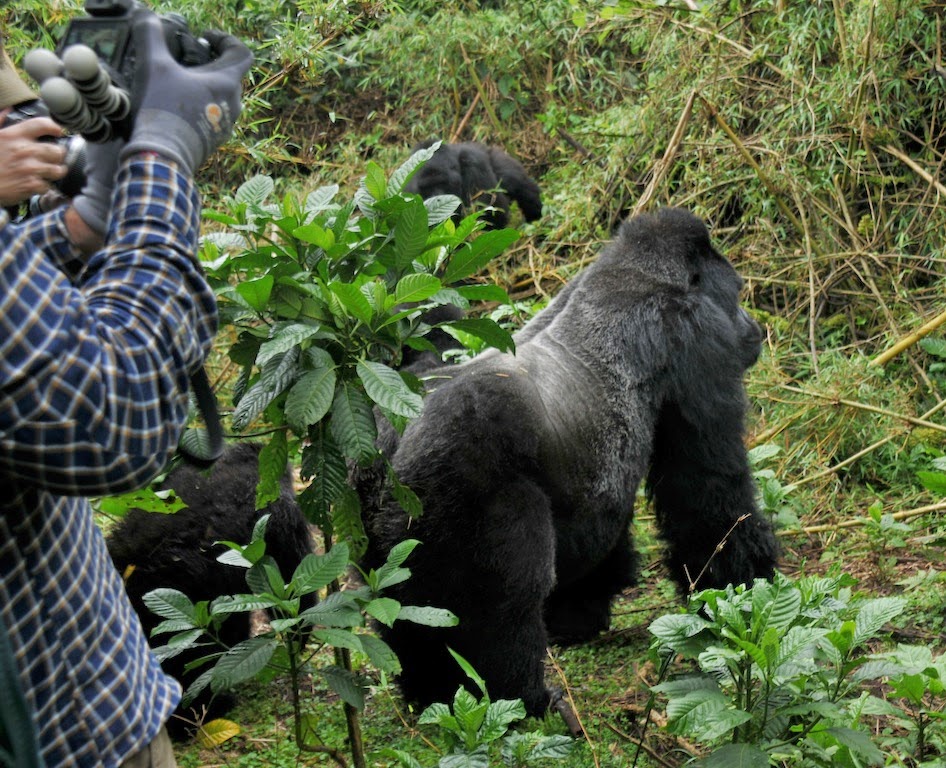
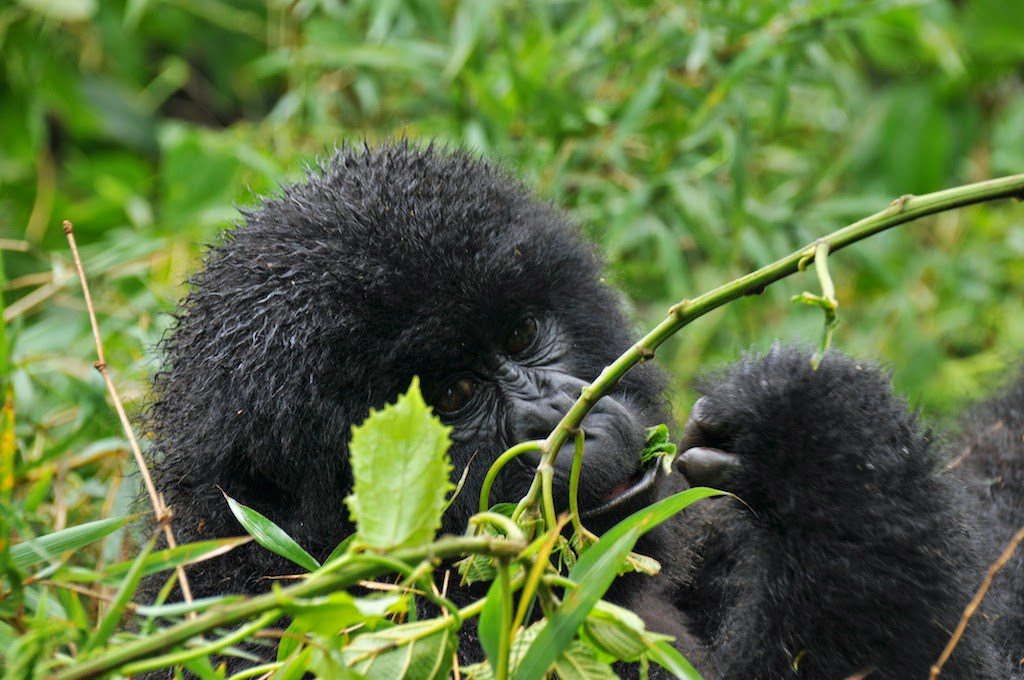


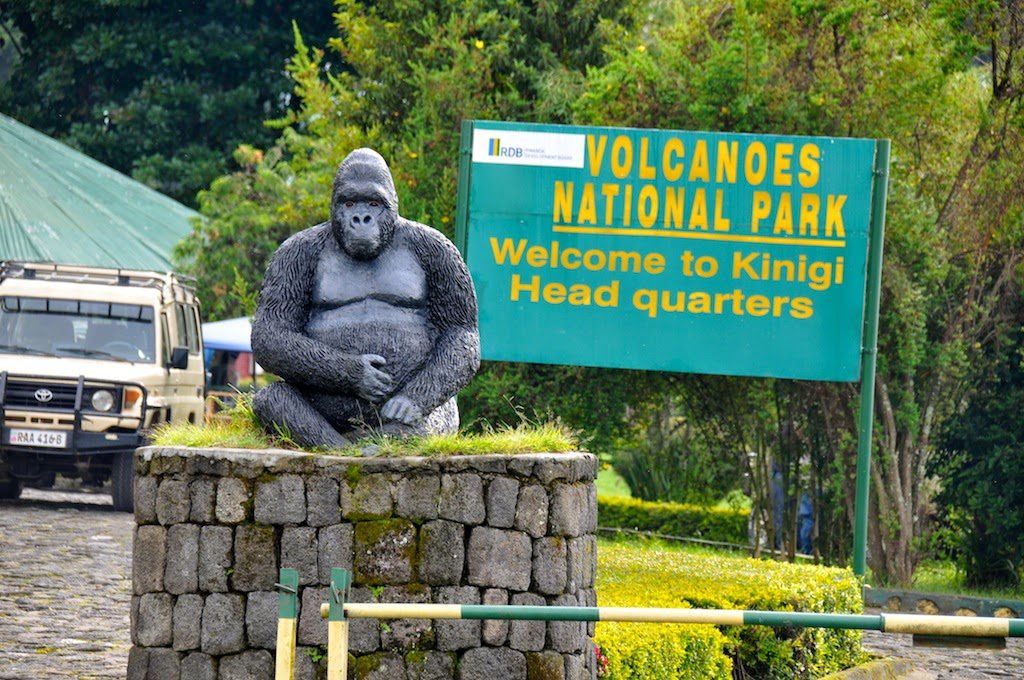
 I awoke at 5, and lay in bed enjoying the space heater I was given, and my soft bed. Then up to trek all morning. I washed, donned my trekking clothes, bandana, sunglasses, gaiters, boots, money, Camelback. Love being outside and hiking! I had internet at last and downloaded all the news, of which there was not much. Ate a breakfast of scrambled eggs, roll, mango and passion fruit.
I awoke at 5, and lay in bed enjoying the space heater I was given, and my soft bed. Then up to trek all morning. I washed, donned my trekking clothes, bandana, sunglasses, gaiters, boots, money, Camelback. Love being outside and hiking! I had internet at last and downloaded all the news, of which there was not much. Ate a breakfast of scrambled eggs, roll, mango and passion fruit.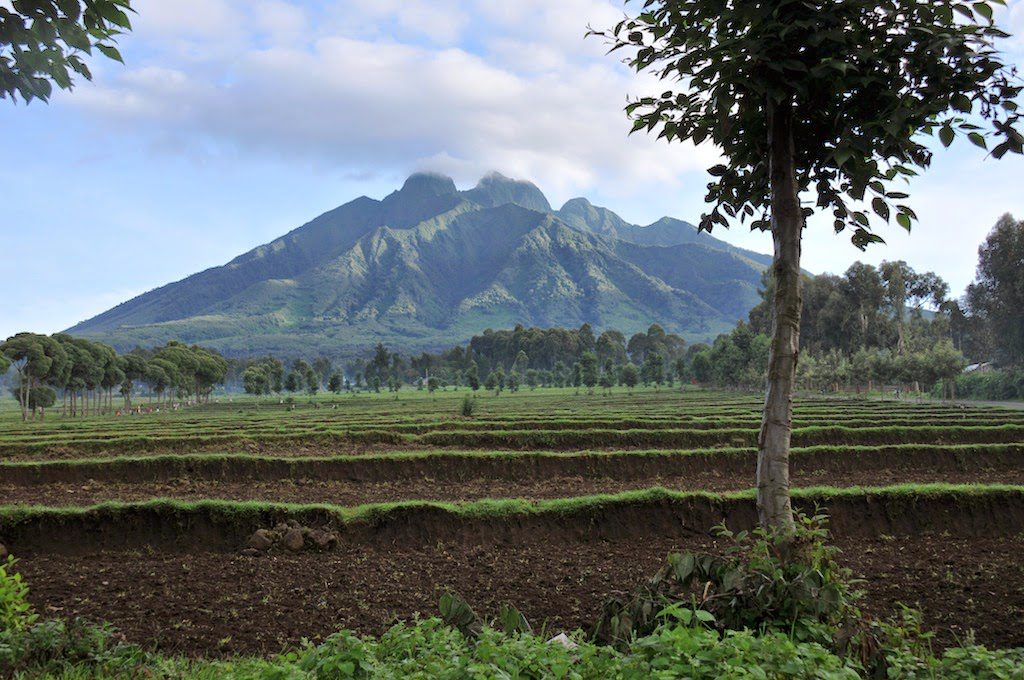 We set off along the bumpiest road I have ever been on. These were magma rocks, spewed out in 1957, when the little volcano last erupted. The rocks were propped every which way, and our SUV had to maneuver them over a long while.
We set off along the bumpiest road I have ever been on. These were magma rocks, spewed out in 1957, when the little volcano last erupted. The rocks were propped every which way, and our SUV had to maneuver them over a long while.their head. Little children, dirty runny noses, barefoot, screeched out “Allo!”
and waved frantically. I reciprocate!
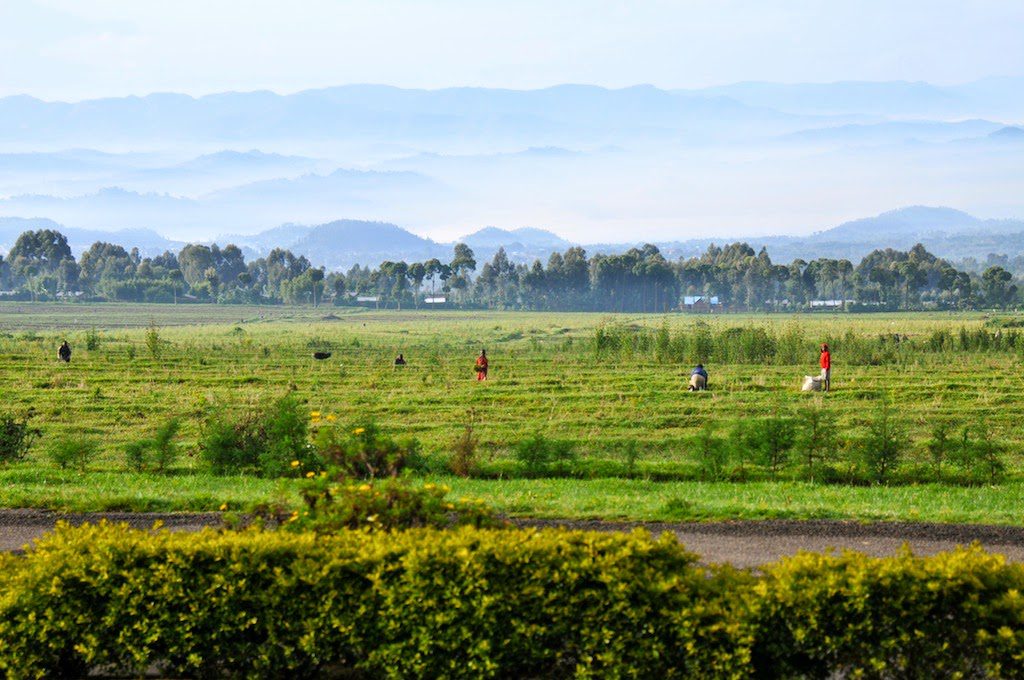 And the backdrop behind this daily opening of a play are the Virunga range
And the backdrop behind this daily opening of a play are the Virunga rangevolcanoes, over million years old. The big one, Sabinio, is named after an “old man’s teeth” because of its ragged outline. It is stunning. The road we drive on is horrifically pitted with magma rocks: we pitch back and forth, as if we are climbing each rock separately. Our stomachs churn. Our slow speed of 3 mph give the children a chance to run alongside. And everywhere area people walking.
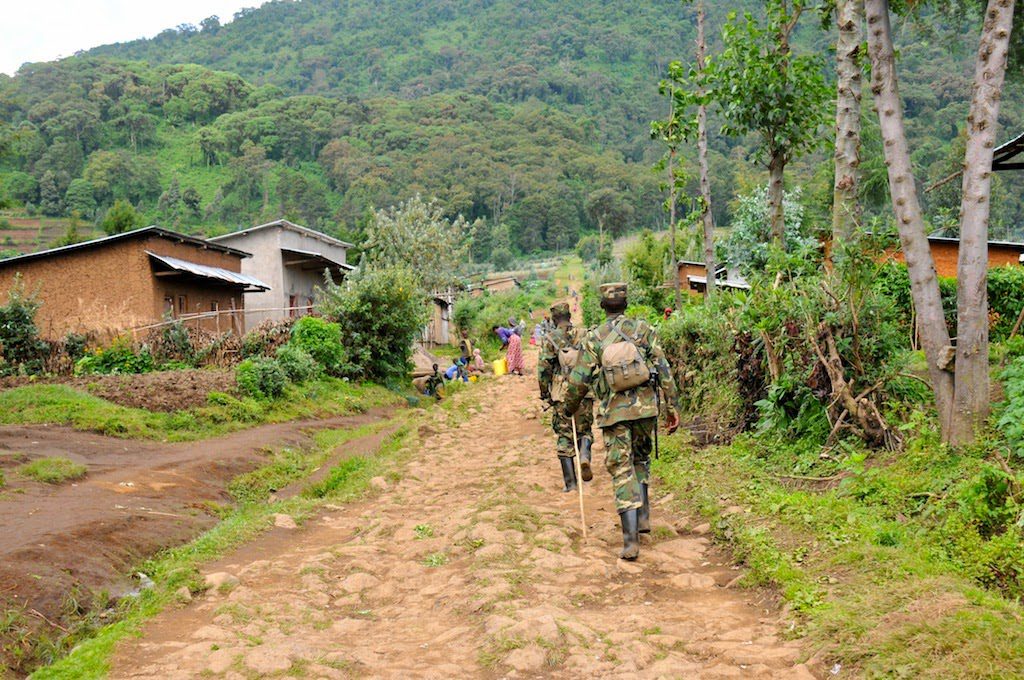 We walk up a long “road” of lava rocks, dusty grey now but still pitted like most
We walk up a long “road” of lava rocks, dusty grey now but still pitted like mostlava rocks are. Ahead are the green slopes of the volcano; on either side, the
village. Mud homes, numerous and playful children, laundry laid out on shrubs,
water pouring out of a pipe that comes from the mountains, and children filling
buckets. The children pour out of their little homes to ogle us. I smile at
each one. The adult are not so friendly. I have four army soldiers with me; two
in front and two behind, to watch for wild buffalo, Lois tells me. And a man in
blue, who I ignore at first but I guess he is part of the park service there to
help me. As if I need help!
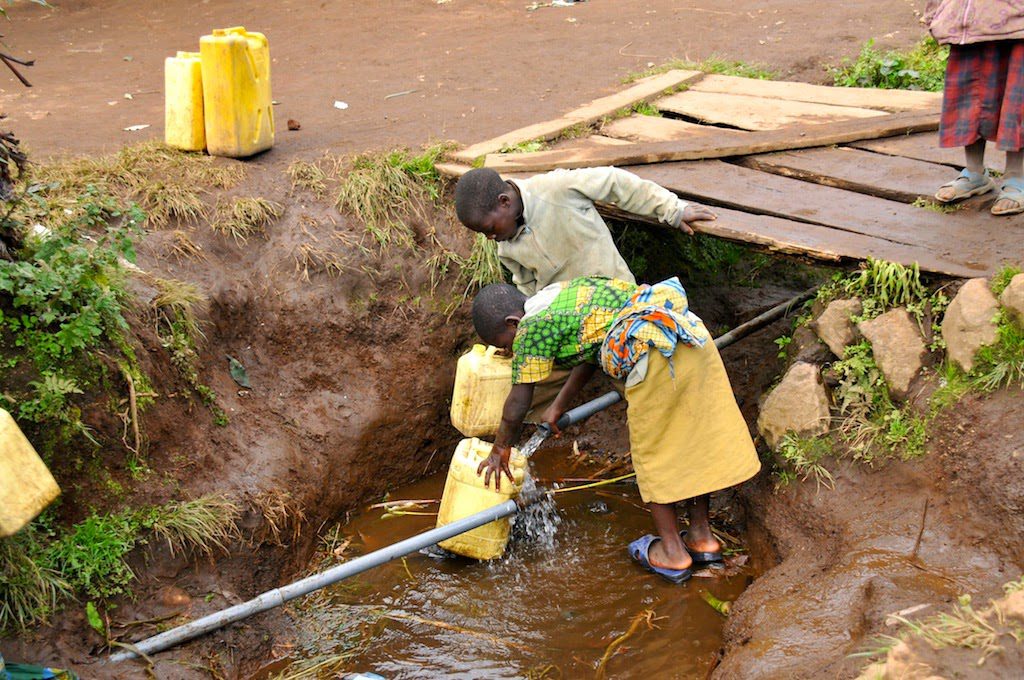 It’s a long hike that morning. The rocky road cutting through the village, then a
It’s a long hike that morning. The rocky road cutting through the village, then agrassy path twisting up the mountain, passing cows and sheep that don’t like
me, then up straight alongside a rocky wall, then into the forest proper. It is
cool but walking makes me hot and I shed my coat. The climb is almost vertical
and slippery. Up past a little footbridge and we are in the forest!
all of Rwanda. Far in the distance are the famous “thousand hills.” Now the
walking is even more treacherous. For the entire time I have to watch my feet.
The path has now been cleared but as it is the rainy season, it’s completely
submerged in mud, covering all the roots and even the white cloth potato sacks
placed there as stepping stones. My boots are able to balance on the roots and
hit the sacks, but every now and then I miss and my feet are engulfed into the
inches thick, black mud. But is feels great! Thick and slimy, it sucks loudly
when I remove my boots or walking stick. Still, I am nimble and surefooted and
keep up with Lois with no problem.
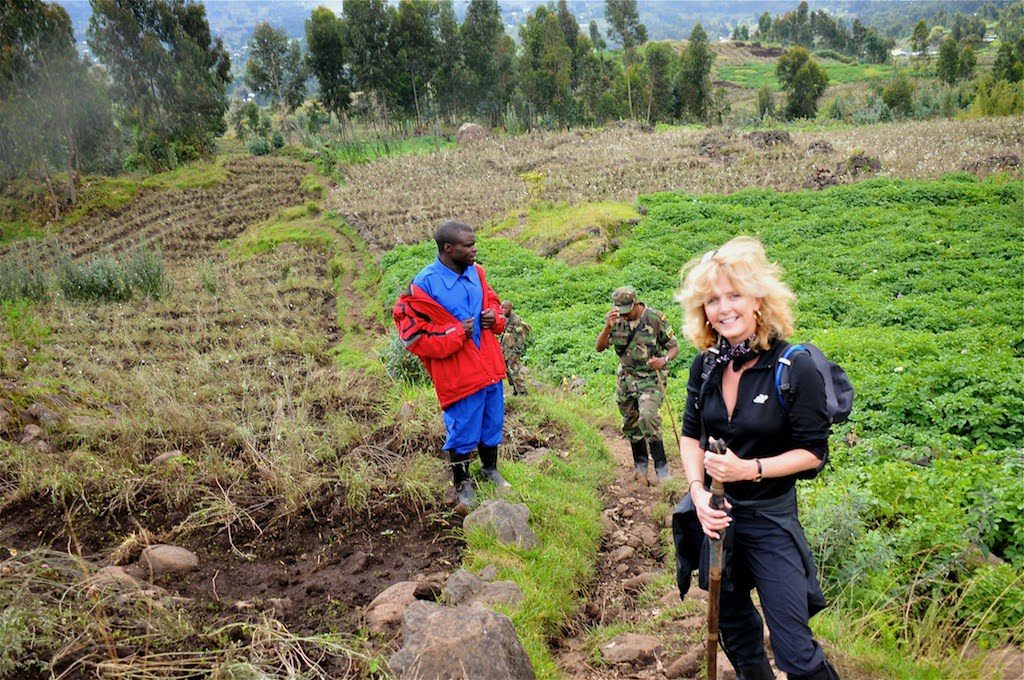 |
| Laurie Kelley hiking to Dian Fossey’ gravesite |
lining the path. A few of these microscopic needles get lodged into my hand,
and they sting and itch relentlessly but there’s nothing to be done. I had
gloves with me in my daypack but neglected to put them on. Every so often I
raise my eyes to gaze at the forest; it is magnificent. Every blade, every
tree, every leaf, a miraculous wonder of an intertwined ecosystem. Lois breaks
off a leaf that she says the gorillas love and I taste it. Nothing at first,
then… bitter!
getting stuck in the mud, avoiding the stinging nettles. Our path weaves in and
out, back and forth to find the best support so we don’t sink in the mud. A few
times my feet miss and I go in over my boots in the mud, and feel water rush
into my socks. By now I have thick mud up to my shins, and a light mist starts
to fall on me. It is glorious. I have never been happier!
and research station were destroyed. All that’s left of her house are a few
posts; I sit on one and Lois snaps my picture. We see the grave and stand over
it as Lois tells me more about Dian’s vicious death by machete.
hiking. Descending is tricky; gravity pulls, while you are a bit tired and the
rocks are slimy with mud. My boots are completely covered in mud, so I slip
easily. Still, I keep a great pace. I love nature; love it, love it and always
want to be outside.
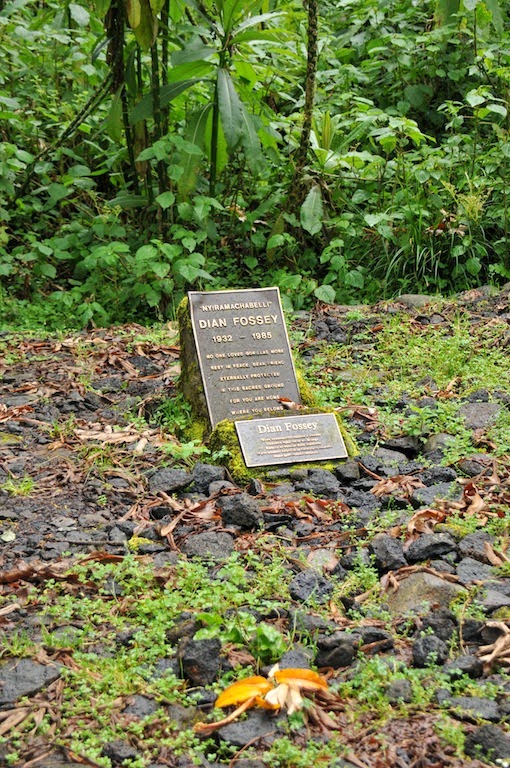
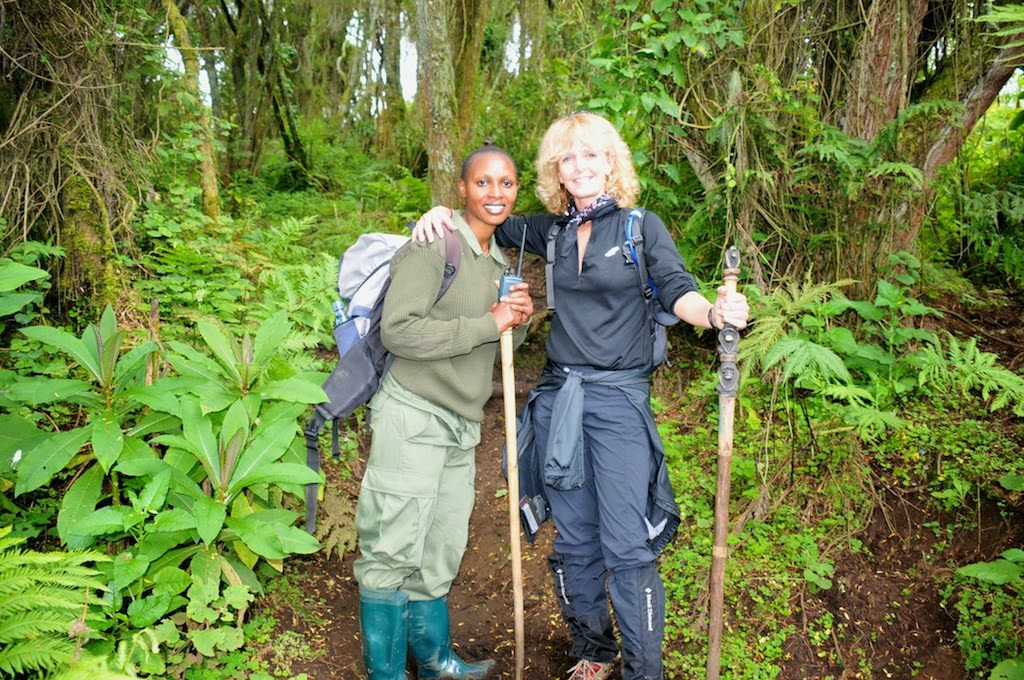 Coming finally into the clearing, though still having to navigate some steep and rocky passes, I tell Lois, It ain’t over yet, Most accidents happen on the way down.
Coming finally into the clearing, though still having to navigate some steep and rocky passes, I tell Lois, It ain’t over yet, Most accidents happen on the way down.who had nothing to do, lurches forward, with “Sorry!” But I hop back up, checking the most important things: my camera lens (which hit hard) and my manicured nails. All’s good. My forearm has an 8-inch superficial gash in it and I have a scraped elbow and my hand has a puncture in it. A bit of blood here and there but I’m good to go.
soaps, toiletries and toothbrush I confiscated from all the hotels. They are so
grateful for anything they get. I give another little boy who was running
alongside the SUV my chocolate protein bar. When I said “chocolate,” his eyes
widened!
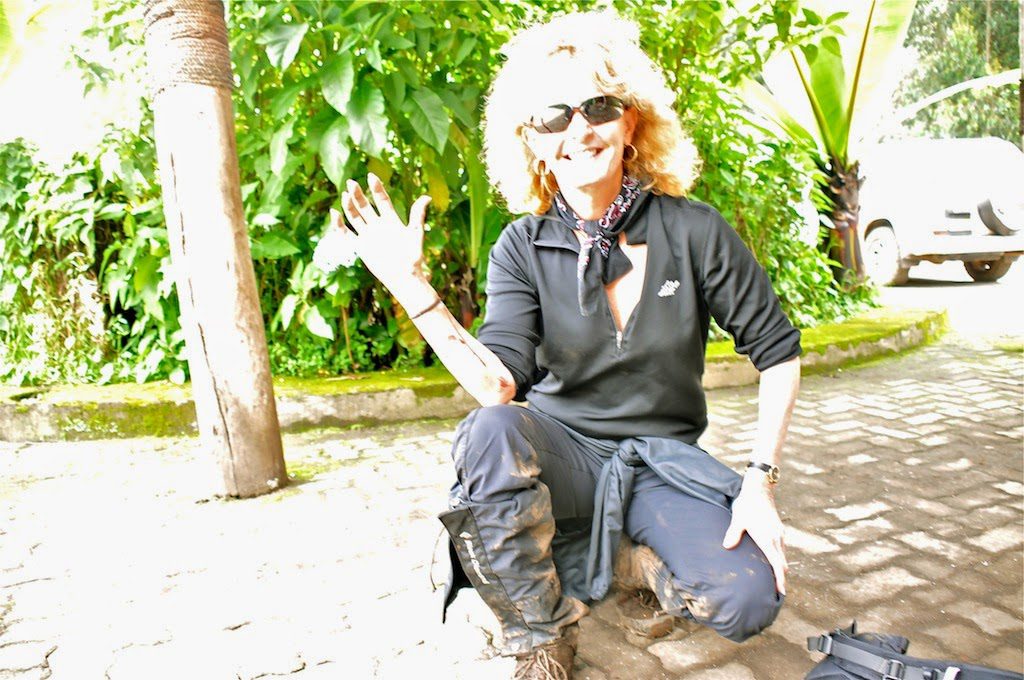 |
| Muddy and bloody! |
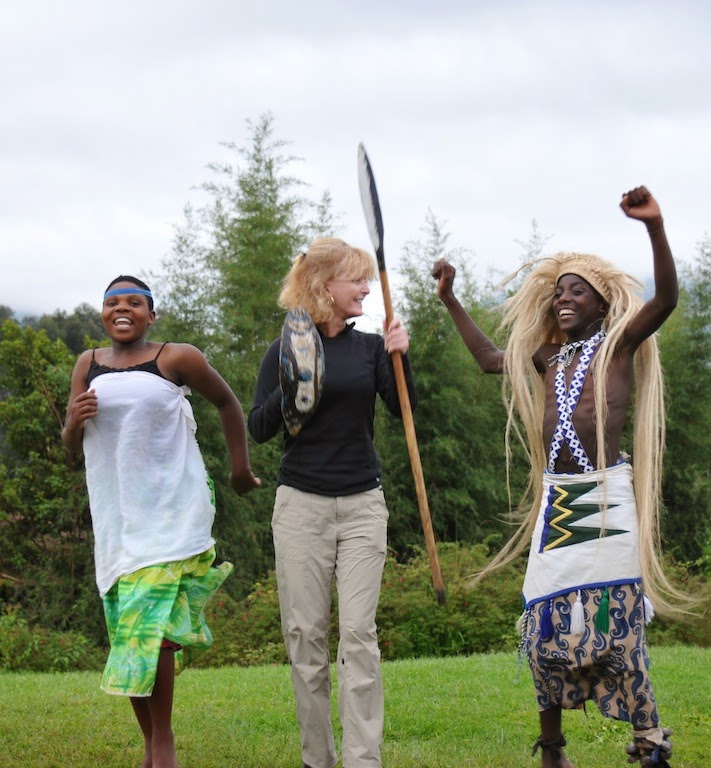 The clouds have now rolled in, and the rain was pelting a while ago. My boots and gaiters
The clouds have now rolled in, and the rain was pelting a while ago. My boots and gaitershave come back to me clean as can be. My wool hiking socks ran red for 20
minutes—I could not soak them enough to get the mud out. Now I sit, enjoying
tea, a warm room, birds chirping outside, peace and quiet in this rich land of
Africa.
rich red earth, the smell of its wood fires and its vibrant humanity. “ Shake Hands with the Devil

